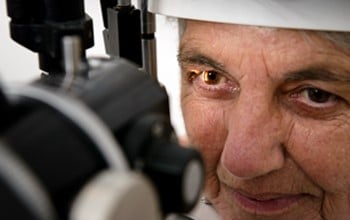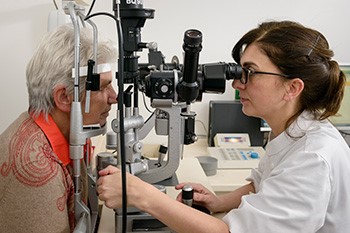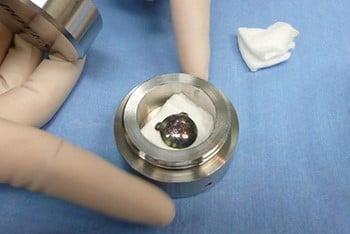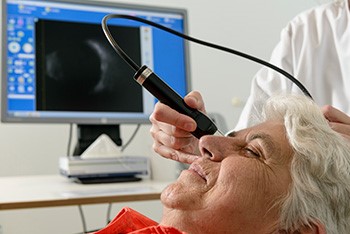Oogmelanoom (oogkanker)
Deze informatie is opgesteld door de afdeling(en) Oogheelkunde.
Wat is Oogmelanoom (oogkanker)?
Een oogmelanoom is een melanoom (een agressief groeiende, kwaadaardige tumor) in het oog. Het wordt ook wel uveamelanoom, oculair melanoom of oogkanker genoemd. De meeste oogmelanomen komen voor bij mensen tussen de 50 en 70 jaar. Een oogmelanoom ontstaat uit een gepigmenteerde cel in het oog. Deze cellen zitten zowel in het regenboogvlies (de iris) als in het vaatvlies. Een irismelanoom is soms ook voor anderen zichtbaar als een groeiende vlek op de iris. Een tumor in het achterste deel van het oog is te zien als een oogarts in het oog kijkt met een oogspiegel.
Verschijnselen
Een oogmelanoom wordt soms bij toeval gevonden tijdens een oogcontrole door de opticien of oogarts. Vaak zijn er klachten van slechter zien. De eerste symptomen van een melanoom in het oog kunnen zijn:
- Vaag zien;
- Het zien van vlekken of lichtflitsen;
- Uitval van een stuk van het gezichtsveld.
Oorzaak
Over de oorzaak van melanomen in het oog is weinig bekend. We weten dat sommige mensen een verhoogde kans hebben op het ontwikkelen van een oogmelanoom: mensen met blauwe ogen, veel sproeten, een lichte huid of die al eerder een huidmelanoom hadden. Er zijn aanwijzingen dat werken met chemicaliën ook leidt tot een verhoogd risico.
Waarom u bij ons in goede handen bent

In het LUMC wordt u geholpen door specialisten die jarenlange ervaring hebben met oogmelanomen. We doen veel onderzoek, zorgen dat u toegang hebt tot de nieuwste behandeltechnieken, en we zorgen er voor dat u zo snel mogelijk kan starten met een behandeling die precies op uw situatie is afgestemd.
Sneldiagnose oogmelanoom
Sinds een aantal jaar biedt het LUMC sneldiagnose aan voor een groot aantal kankersoorten, waaronder oogmelanomen. Zo kunnen wij u zo snel mogelijk laten weten of u kanker hebt en welke behandelingen mogelijk zijn.
We houden altijd een aantal plekken in ons spreekuur gereserveerd voor sneldiagnose. U kunt dan ook altijd binnen een paar werkdagen bij ons terecht. Het LUMC is het enige centrum in Nederland dat sneldiagnose aanbiedt voor oogmelanomen.
Bestraling met een Rutheniumschildje
Het LUMC biedt ook als enig centrum in Nederland Ruthenium brachytherapie aan. Dit is een hele precieze en plaatselijke bestraling met een radioactief schaaltje. Met deze unieke methode kunnen we heel gericht het oogmelanoom te lijf gaan. De afdelingen Oogheelkunde en Radiotherapie werken hiervoor intensief samen. Bij de behandeling van oogmelanoom richten wij ons altijd op uw individuele situatie. Omdat een tumor in het oog uitzaaiingen kan geven, werkt de afdeling Oogheelkunde ook intensief samen met de afdeling Klinische Oncologie.
Wetenschappelijk onderzoek naar oogmelanoom
Het LUMC loopt voorop als het gaat om wetenschappelijk onderzoek naar oogmelanomen. We doen veel onderzoek naar betere onderzoeksmethoden en behandelingen. We onderzoeken bijvoorbeeld hoe we aan de hand van kenmerken van de tumor nog beter kunnen voorspellen hoe deze zal reageren op de behandeling. En we bereiden ons voor op de komst van een protonenbestraler in Delft. Daarmee kunnen ook patiënten met grotere oogmelanomen straks met grote precisie bestraald worden.

Clinical trials
Op de polikliniek Oogheelkunde lopen de nieuwste medische studies (clinical trials). Mogelijk vragen wij u hieraan mee te doen. Momenteel loopt er een studie naar het nut van een heel precieze oog-MRI. Daarnaast doen we mee aan studies naar het effect van nieuwe medicijnen en behandelingen bij oogmelanoom-patiënten met uitzaaiingen.
Nieuwe kennis
Het LUMC staat bekend om de sterke band tussen de kliniek en het laboratorium, zeker op het gebied van de immunologie. Dit ‘translationele’ onderzoek geeft ons nieuwe kennis over ziekten en patiënten en leidt tot nieuwe behandelingen, ook als het gaat om oogmelanomen. Zo heeft de afdeling Oogheelkunde van het LUMC laten zien dat oogmelanomen en huidmelanomen op immunologisch gebied volstrekt anders zijn. Een belangrijk inzicht, waarop nu in Europees verband voortgebouwd wordt.
Is er bij u sprake van verdenking op een oogmelanoom? Dan kunt u bij het LUMC terecht voor sneldiagnose. Iedere dinsdag houdt de polikliniek Oogheelkunde oncologiespreekuur. We proberen u altijd op de eerste dinsdag na aanmelding een afspraak te geven bij een van onze oogartsen, gespecialiseerd in oncologische aandoeningen.
Afspraak maken voor sneldiagnose oogmelanoom
U wordt meestal aangemeld voor sneldiagnose door een oogarts van een ander ziekenhuis. In sommige gevallen kan de huisarts doorverwijzen. De secretaresse van onze polikliniek belt u voor het maken van een afspraak.
Op de afgesproken dinsdag kunt u zich melden aan de balie van de polikliniek Oogheelkunde op J3 van het LUMC. Zelfverwijzing is in het geval van oogmelanoom moeilijk, omdat de klachten die een tumor kan geven ook bij andere oogaandoeningen kunnen passen.

Wie komt u tegen en wat kunt u verwachten?
Het oogheelkundig oncologisch team bestaat uit oogartsen, technisch oogheelkundige assistenten, medische fotografen en een oncologieverpleegkundige. Uw bezoek aan de polikliniek verloopt als volgt:
Het onderzoek
- De technisch oogheelkundig assistent roept u in de behandelkamer en vraagt u naar uw medicijngebruik en uw oogheelkundige geschiedenis. Hij of zij meet uw gezichtsvermogen en oogdruk. Ook krijgt u pupilverwijdende oogdruppels.
- De oogarts bekijkt uw oog uitgebreid van binnen (een zogenaamde fundusscopie). Soms is het nodig een lens op uw oog te zetten om ook goed in de hoek van uw oog te kunnen kijken. Daarna wordt een echo van het oog gemaakt. Zo kan de arts de binnenkant van uw oog bekijken en de aard van het tumorweefsel vaststellen.
- De medisch fotograaf maakt foto’s van de binnenkant van het oog. Om het vaatpatroon in het oog duidelijk te kunnen zien, is het meestal nodig om contrastvloeistof in de arm te spuiten.
Uitslag van het onderzoek
- De oogarts en de oncologieverpleegkundige vertellen u uw diagnose. Als er sprake is van een oogmelanoom, bespreken ze met u de behandelmogelijkheden. Er zal ook een screening van de rest van het lichaam nodig zijn. Soms kan deze screening al (gedeeltelijk) op dezelfde dag gebeuren.
- De oncologieverpleegkundige spreekt alles nogmaals met u door en legt het tijdspad tot de behandeling uit. Ze geeft u ook folders met informatie mee.
De onderzoeken om tot een diagnose te komen duren ongeveer een halve dag. Door het druppelen van uw ogen kunt u de eerste uren na het onderzoek zelf geen autorijden.

Welke behandelingen zijn er mogelijk?
Als bij u een oogmelanoom is vastgesteld, dan zoeken we direct naar een behandeling die het beste bij u past. Oogmelanomen zijn zeer zeldzaam en ieder persoon is anders. Daarom is het goed om te weten dat u bij ons behandeld wordt door een team van specialisten dat jarenlange ervaring heeft met oogmelanomen. Bovendien biedt het LUMC als Nederlands grootste oogmelanoomcentrum behandelingen die u nergens anders in Nederland kunt krijgen. Uw arts bespreekt met u welke mogelijkheden er allemaal zijn in uw situatie. Zo komen we samen tot een passend behandelplan.
Overleg tussen patiënt en arts
Wat de beste manier is om een oogmelanoom te behandelen, hangt af van een aantal factoren. Bijvoorbeeld de plaats van de tumor in het oog en de grootte. Uw behandelend arts bespreekt samen met u welke behandeling het beste bij uw situatie past. U krijgt daarbij altijd inzicht in de afwegingen die bij de behandelkeuze een rol spelen. Want de keuze voor een behandeling nemen we niet zomaar. Er zijn verschillende belangrijke factoren waar we rekening mee houden. Zo gaan we voor maximale bestrijding van de tumor, maar proberen we ook altijd het oog en het zicht te behouden, en pijnklachten te voorkomen.
Welke behandelingen zijn er?
Er zijn verschillende manieren om een oogmelanoom te behandelen:
- Bestraling met een Rutheniumschildje
- Uitwendige bestraling
- Protonen bestraling
- Stereotactische bestraling
- Lasertherapie
- Verwijdering van het oog
Bestraling met een Rutheniumschildje
Bestraling met een Rutheniumschildje is in Nederland alleen bij het LUMC mogelijk. Met deze zeer plaatselijke manier van bestralen kunnen we het weefsel rondom de tumor zo veel mogelijk sparen. Bij de behandeling met Rutheniumschildje wordt gebruik gemaakt van een radioactief schaaltje (een soort bolvormig muntje) dat straling afgeeft om de tumor te vernietigen. Dit schaaltje brengen we aan de buitenkant op de oogbol aan, op de plaats waar de tumor zich in het oog bevindt. Het aanbrengen van het schaaltje gebeurt tijdens een operatie, die meestal onder algehele narcose wordt verricht. Het schaaltje zal 3 tot 10 dagen op het oog moeten blijven zitten. Dit is afhankelijk van de hoeveelheid straling die nodig is. Tijdens deze periode blijft u in het ziekenhuis opgenomen. Het precieze aantal dagen dat u opgenomen moet blijven, hoort u op de eerste dag van uw opname van de radiotherapeut.
Het schaaltje wordt na de bestralingsperiode onder plaatselijke verdoving verwijderd en u krijgt een verband op het oog. Na deze ingreep kunt u weer naar huis. De tumor zal in de loop van maanden na de behandeling langzaam verschrompelen. Een enkele keer komt het voor dat de tumor onvoldoende op de behandeling heeft gereageerd. Dan is het noodzakelijk de tumor opnieuw te behandelen.

Uitwendige bestraling
Als de tumor groot is of op een moeilijk bereikbare plaats zit, is uitwendige bestraling een optie. Er zijn 2 mogelijkheden:
Protonen bestraling
Bij protonentherapie wordt de tumor in het oog zo precies mogelijk bestraald met protonen. Deze behandeling vindt plaats in het HollandPTC in Delft. Voorafgaand aan de protonenbestraling maken we tijdens een operatie in het LUMC de tumor zichtbaar met markeerclipjes voor de planning en controle van de bestraling.
In het HollandPTC vinden eerst enkele voorbereidingen plaats, gevolgd door een zogeheten dry run. Dit is een soort generale repetitie waarbij nog geen bestraling plaatsvindt. Hierna wordt de tumor op 4 achtereenvolgende dagen bestraald. Dit gebeurt poliklinisch. De controles na afloop van de bestraling vinden plaats bij de oogarts in het LUMC.
Video: Voorlichting protonen radiotherapie voor oogmelanomen
Stereotactische bestraling
Met deze techniek wordt de tumor van verschillende kanten bestraald, waarbij het bestralingstoestel om uw hoofd draait. Een soort frame houdt uw hoofd in de juiste positie. Deze behandeling vindt op 5 achtereenvolgende dagen poliklinisch plaats in het Erasmus Medisch Centrum in Rotterdam.
Lasertherapie
Soms combineren we de bestralingstherapie met een laserbehandeling. Met infrarode laserstralen verwarmen we de tumor tot een temperatuur waarop de tumorcellen worden vernietigd. Deze behandeling gebeurt poliklinisch. De voorbereiding bestaat uit het geven van pupilverwijdende oogdruppels en een plaatselijke verdoving onder het te behandelen oog. Dit duurt ongeveer 45 minuten. Hierna vindt de behandeling plaats. Deze duurt ongeveer 30 minuten. Na de behandeling krijgt u oogzalf en een verband op het oog.
Het oog verwijderen
Het kan zijn dat u niet in aanmerking komt voor bestraling, omdat de tumor te groot is of op een ongunstige plaats zit. In dat geval is verwijdering van het oog de beste behandelmethode. Deze operatieve ingreep gebeurt onder algehele narcose en duurt ongeveer een uur. U blijft ongeveer 2 nachten in het ziekenhuis. Tijdens de operatie verwijderen we de oogbol en brengen we meteen een implantaat in de oogkas in. Dit om de ontstane ruimte op te vullen en om de oogspieren aan vast te zetten. De operatie vindt soms plaats in uw eigen ziekenhuis, maar meestal in het LUMC. 4 tot 6 weken na de operatie kunt u een oogprothese laten maken. Dit is een schaaltje dat precies lijkt op uw eigen oog. De prothese wordt aangemeten door iemand die zich gespecialiseerd heeft in het maken van oogprotheses (een ocularist).
Screening op uitzaaiingen
Ook als het oogmelanoom in een vroeg stadium ontdekt is, kunnen er in de loop der tijd uitzaaiingen ontstaan. Hoe groter de tumor, hoe groter de kans dat zich uitzaaiingen vormen. Als er uitzaaiingen zijn, worden deze meestal in de lever gevonden. Om die reden adviseren wij u halfjaarlijks een echo van de lever te laten maken. Als uw oog is verwijderd of er een biopt is genomen van de tumor, is het mogelijk om op basis van het verkregen tumormateriaal vast te stellen of u een hoge of lage kans hebt op uitzaaiingen.
Hoe kunt u zich op de behandeling voorbereiden?
Het horen van de diagnose oogmelanoom en het ondergaan van de behandeling kan zeer ingrijpend zijn. Daarom is het goed als u zich oriënteert. We zullen u zo goed mogelijk begeleiden en voorlichten. Daarnaast kunt u over de ziekte lezen en erover praten met uw familie en vrienden.
Vragen kunt u altijd stellen in het gesprek met uw behandelaar of aan ons verpleegkundig aanspreekpunt, de oncologieverpleegkundige. Deze kunt u ook bellen als er thuis opeens vragen boven komen. De verpleegkundige is bereikbaar via de polikliniek Oogheelkunde: tel. 071 - 526 23 79 (bereikbaar tijdens kantooruren).
Wat is de prognose?
De overleving van patiënten met een oogmelanoom is sterk afhankelijk van de grootte van de tumor. Het percentage van de oogmelanoompatiënten dat 5 jaar na het stellen van de diagnose nog in leven is, is ruim 70%. Kenmerken van de tumor en uw persoonlijke omstandigheden zijn van invloed op uw persoonlijke prognose. Wat u zelf kunt verwachten, kunt u het beste met uw behandelend arts bespreken.
Meedoen aan wetenschappelijk onderzoek
Het LUMC doet veel wetenschappelijk onderzoek naar oogmelanoom. Zo hebben we een biobank, waarin we weefsels opslaan voor onderzoek. We doen onderzoek in ons laboratorium en we werken aan nieuwe beeldvormende technieken zoals een speciale hoog-resolutie MRI-scanner. Ook werken we veel samen met toonaangevende instituten in binnen- en buitenland. Momenteel doet het LUMC mee aan meerdere medische studies naar experimentele behandelingen (clinical trials). Mogelijk vragen wij u hieraan mee te doen.
Na uw behandeling van het oogmelanoom kunt u te maken krijgen met verschillende vormen van nazorg. Dit is afhankelijk van het type behandeling dat u hebt ondergaan.
Welke specifieke nazorg kunnen we bieden bij deze aandoening?

U blijft na de behandeling onder controle van uw oogarts. Bij deze controles beoordelen we hoe de tumor op de behandeling heeft gereageerd. U komt in ieder geval na 3 maanden op controle, en meestal 3 tot 4 maanden daarna weer. De controles lopen meerdere jaren door. Bij elk bezoek worden de ogen bekeken. We kunnen een echo maken om eventuele veranderingen in de tumor vast te stellen. Vaak zien we dat de tumor langzamerhand kleiner wordt. Door de bestraling kunnen complicaties ontstaan, zoals bloedingen of lekkage van vocht in het netvlies. Daarom is het belangrijk om onder controle te blijven.
Welke nazorg bieden wij na een operatie?
Hebt u een operatie gehad om een oog te verwijderen? Dan wordt u na 2 weken door onze oncologieverpleegkundige gebeld. 4 tot 6 weken na de operatie kunt u een oogprothese laten aanmeten. Na 6 tot 8 weken komt u ter controle op de polikliniek.
Begeleiding
Het krijgen van kanker en het ondergaan van een behandeling kan ingrijpend zijn. De oncologisch maatschappelijk werkers van het LUMC kunnen u helpen bij de verwerking.
Waar moet u op letten na uw behandeling?
Waar moet u op letten na een bestraling?
Na behandeling met een bestralingsplaatje kan dubbelzien optreden. Dit komt doordat de oogspieren tijdens de bestraling soms van hun plaats moeten worden gehaald. Bij het verwijderen van het bestralingsplaatje wordt dit weer hersteld, maar het kan enige weken duren voor de dubbelbeelden bijtrekken. Heel soms is een operatie nodig om het dubbelzien te verhelpen. Bij de behandeling met een bestralingsplaatje kunnen ook bloedingen optreden, die meestal na enkele weken verdwijnen. Na de operatie kunt u pijn of irritatie ervaren. U kunt dan pijnstillers krijgen.
Een andere complicatie na een bestraling is bestralingsretinopathie. Dit is schade aan de bloedvaten van het netvlies, als gevolg van bestraling. De symptomen hiervan treden meestal pas op na 4 maanden tot 3 jaar. Er vormen zich nieuwe bloedvaten in het netvlies die kunnen gaan bloeden of er ontstaat zuurstoftekort. Hierdoor wordt het zicht slechter. Uw arts zal hier tijdens de controles alert op zijn.
Waar moet u op letten na een operatie?
Tijdens een operatie om het oog te verwijderen kunnen bloeduitstortingen optreden die na enkele weken spontaan verdwijnen. Bij hoge uitzondering ontstaan infecties en ontstekingen. Indien nodig krijgt u hiervoor antibiotica of ontstekingsremmers.
Contact bij problemen na uw behandeling
Loopt u na uw behandeling tegen problemen aan? Geef dit aan bij de nacontroles, of eerder als ze urgent zijn. Bel dan met de polikliniek Oogheelkunde: tel. 071-5262379 (bereikbaar tijdens kantooruren). De oncologieverpleegkundige zal uw vragen beantwoorden of uw probleem voorleggen aan een van de artsen. Buiten kantooruren kunt u zich bij zeer urgente problemen melden bij de spoedeisende hulp van het LUMC.
Behandelteam
De oogarts is uw regievoerend arts. U kunt met uw vragen bij hem of haar terecht, of bij de gespecialiseerde verpleegkundige.

Drs. J.C. Bleeker
Oogarts

Prof. dr. G.P.M. Luyten
Oogarts
Afdelingshoofd Oogheelkunde

Drs. M. Marinkovic
Oogarts

Dr. T.H.K. Vu
Oogarts

Prof. dr. C.L. Creutzberg
Radiotherapeut-oncoloog

Dr. H.W. Kapiteijn
Internist-oncoloog

Prof.dr. C.R.N. Rasch
Radiotherapeut-Oncoloog

Mw.dr. P.A.C. Bakker
Radiotherapeut-Oncoloog
Wie kunt u nog meer tegenkomen?
- Verpleegkundige: B. Stange
- Verpleegkundige: L.E. Steenbergen
Aan welke studies kan je meedoen?
Patiëntgebonden onderzoek
Ons patiëntgebonden onderzoek richt zich op het verbeteren van de plaatselijke bestraling en het voorkomen en behandelen van complicaties die bij bestraling voor kunnen komen. Omdat ons laboratorium en de kliniek nauw samenwerken, kunnen we onderzoeksresultaten snel doorvertalen naar behandelingen voor patiënten.
Onderzoek in het lab
In het laboratorium verdiepen wij ons in de genetische factoren die mogelijk een rol spelen bij het ontstaan van oogmelanoom. Ook kijken we naar de eigenschappen van oogtumoren. De aanwezigheid van bepaalde enzymen in een tumor kan ons mogelijk iets vertellen over de gevoeligheid voor chemo-, immuno-, en doelgerichte therapie. In het laboratorium kweken we tumoren en testen we hun gevoeligheid voor nieuwe medicijnen. Ook het afweersysteem van de patiënt heeft invloed op de ontwikkeling van oogmelanomen. We onderzoeken of het mogelijk is het afweersysteem zo te beïnvloeden dat het de tumor en uitzaaiingen aanvalt en opruimt.
Het LUMC staat bekend om het wetenschappelijk onderzoek over de rol van het afweersysteem bij kanker. Zo beschreven wij als eerste dat het oogmelanoom grote verschillen vertoont met het huidmelanoom. Hier wordt nu ook in Europees verband onderzoek naar gedaan. Omdat een oogmelanoom een zeldzame aandoening is, werken we wereldwijd samen met andere onderzoeksinstituten.

Samenwerkingsverbanden
Oogheelkunde werkt binnen het LUMC samen met vele afdelingen. Zo kunnen we het onderzoek naar en de behandeling van oogmelanoom optimaal uitvoeren. Met de afdeling Radiologie werken we samen aan manieren om het oog beter in beeld te brengen. Met afdelingen als Humane Genetica, Moleculaire Genetica, Pathologie, Klinische Oncologie, Radiologie, Immunologie werken we aan het verbeteren van de kennis over het ontstaan van oogmelanomen en de rol van het afweersysteem.
Buiten het LUMC werken we samen met de Vrije Universiteit Amsterdam en het Erasmus Medisch Centrum in Rotterdam, en in het buitenland met het Curie Institute in Parijs, de University of Liverpool, de Universiteiten van Miami en het Schepens Eye Research Institute van Harvard Medical School.
Publicaties
Onze onderzoekers publiceren regelmatig in toonaangevende medische tijdschriften. Bekijk een lijst met publicaties van de afdeling Oogheelkunde.
Contact
Wilt u meer weten of hebt u nog vragen? Neem dan contact met ons op of volg de links voor aanvullende informatie.
Patiëntportaal mijnLUMC
In het patiëntportaal mijnLUMC vindt u een duidelijk overzicht van uw behandelingen en hebt u inzicht in uw medische gegevens. Snel en veilig. Thuis, onderweg en in het ziekenhuis.
Patiënt verwijzen
Informatie voor artsen en instellingen die patiënten naar het LUMC willen verwijzen.
Contactgegevens voor patiënten
- Polikliniek Oogheelkunde: 071 - 526 23 79
Overig
Oogmelanoom kan uitzaaien. Als de uitzaaiingen niet meer geopereerd of weggebrand kunnen worden, is uitgezaaid oogmelanoom over het algemeen niet meer te genezen. Er zijn nog geen standaardbehandelingen beschikbaar. Wel kunnen we proberen de ziekte te stabiliseren of te remmen met experimentele behandelingen. De afdeling Medische Oncologie doet bovendien mee aan studies naar het effect van nieuwe medicijnen en behandelingen bij oogmelanoom-patiënten met uitzaaiingen.
Als bij u uitzaaiingen zijn gevonden, krijgt u binnen een week na verwijzing een afspraak bij de polikliniek Medische Oncologie. Na de eerste afspraak en de eventuele extra onderzoeken stellen we in overleg met u een behandelplan op.
Onderzoek
Bij uitgezaaid oogmelanoom hebben er vaak al een aantal onderzoeken plaatsgevonden op andere afdelingen of in andere ziekenhuizen. Indien nodig worden deze herhaald, of komt er nog aanvullend onderzoek bij.
U hebt een afspraak met een medisch oncoloog, soms met een oncoloog in opleiding erbij. Het onderzoek kan bestaan uit een bloedonderzoek en een CT, PET-CT of MRI-onderzoek. Vaak is het nodig een punctie van de uitzaaiing te doen voor pathologisch onderzoek en genmutatie-analyse.
Uitslag van het onderzoek
Zijn alle onderzoeken gedaan? Dan komt u terug op de polikliniek Medische Oncologie. Uw medisch oncoloog bespreekt met u de uitslagen en het behandelplan. Als al het benodigde onderzoek al eerder heeft plaatsgevonden, bespreken wij het behandelplan mogelijk al tijdens de eerste afspraak.
Hoe kunt u zich voorbereiden?
- Schrijf uw vragen aan de medisch oncoloog op, zodat u ze niet vergeet.
- Voorafgaand aan het eerste consult krijgt u een vragenlijst over uw medische voorgeschiedenis en medicijngebruik. Vul deze in en neem hem mee.
- Neem iemand mee om met u mee te denken en u te ondersteunen.
- Meer informatie over uitgezaaid oogmelanoom vindt u op kanker.nl en de website van de Stichting Melanoom.
Behandeling
Voor oogmelanoom zijn nog geen goede standaardbehandelingen beschikbaar. De behandelingen die wij aanbieden zijn nog in de onderzoeksfase. Uw medisch oncoloog zal met u bespreken voor welke behandeling u eventueel in aanmerking komt. Dit is afhankelijk van uw leeftijd en conditie, uw bloedwaarden en de hoeveelheid en locatie van de uitzaaiingen. Er zijn een aantal experimentele behandelopties mogelijk:
Leverperfusie
Bij patiënten onder de 70 jaar met alleen leveruitzaaiingen kan een perfusie van de lever met chemotherapie de ziekte voor langere tijd remmen. In het LUMC wordt onderzoek gedaan naar deze behandeling.
Middelen gericht op genmutaties
Het LUMC doet mee aan internationale studies naar middelen waarvan er een aantal gericht zijn op genmutaties die specifiek bij oogmelanoom voorkomen (GNA11 en GNAQ mutaties).
Immunotherapie
De middelen anti-PD1 en ipilimumab worden momenteel gegeven bij uitgezaaid huidmelanoom, maar we weten nog niet of deze behandelingen hetzelfde effect hebben bij uitgezaaid oogmelanoom. Hier wordt landelijk, door ons opgestart, onderzoek naar gedaan.
Chemotherapie
Chemotherapie wordt soms geprobeerd, maar heeft zeer tegenvallende resultaten. Daarom kiezen we niet vaak voor deze optie.
Wat is de prognose?
De overlevingskansen bij uitgezaaid oogmelanoom zijn beperkt. De kenmerken van de tumor, het aantal uitzaaiingen en uw medische omstandigheden zijn van invloed op uw persoonlijke prognose. Wat u zelf kunt verwachten, kunt u het beste met uw behandelend arts bespreken.
Nazorg
Patiënten met uitgezaaid melanoom blijven bij de medisch oncoloog onder controle zolang er behandeld wordt of als de ziekte gestabiliseerd is. Het kan helaas ook voorkomen dat er geen behandeling meer mogelijk is. Uw huisarts neemt dan meestal de zorg over.
Begeleiding
Het krijgen van kanker en het ondergaan van een behandeling kan ingrijpend zijn. De oncologisch maatschappelijk werkers van het LUMC kunnen u helpen bij de verwerking. U kunt ook hulp krijgen van het Palliatief Advies Team van het LUMC.
Waar moet u op letten na de behandeling?
Elke behandeling heeft bepaalde bijwerkingen. Tijdens uw bezoeken de polikliniek Medische Oncologie krijgt u hier uitgebreide informatie over. Ook krijgt u telefoonnummers mee, die u kunt bellen bij klachten.
Hoe kunt u ons bereiken?
Heeft u vragen, zorgen, of wilt u meer informatie? Bel dan de polikliniek Medische Oncologie: tel. 071 - 526 35 23 (tijdens kantooruren). Bij acute klachten van de behandeling of de uitzaaiingen kunt u ook bellen met de afdeling Medische Oncologie: tel. 071 - 526 31 90 (in de avond, nacht en weekenden).